- Home
- Robin Cook
Host Page 7
Host Read online
Page 7
Despite her efforts at control, tears brimmed and some spilled over Lynn’s cheeks. She wiped away the moisture with a knuckle of her first finger. “I know I’m going to feel a certain amount of guilt no matter what; I know myself well enough. But what about his parents? They had wanted him to have his surgery over at Roper Hospital. Why did I interfere?”
Carl’s father was a lawyer in Charleston like his son but at a different firm and involved in a different specialty. The father’s area of interest was litigation and criminal law, unlike Carl’s emphasis on real estate and corporate law. His mother was an elementary school teacher. The parents lived in the same house in West Ashley where Carl had grown up. Lynn had met them on numerous occasions, particularly over the last several years, as Lynn and Carl’s relationship had solidified. Even Michael had met them for a couple of celebratory birthday dinners.
“The Vandermeers are smart people,” Michael said. “And it’s easy to see they care for you. They are not going to blame you. No way!”
“I’m not sure I wouldn’t if I were them.”
“But we’re jumping the gun here. We don’t really know as an absolute certainty what’s going on. Here’s my take: Let’s hightail it up to the neuro ICU before our dermatology lecture and check out Carl’s chart.” Mason-Dixon Medical Center had a fully integrated EMR, but there were still physical charts for inpatients while they were in the hospital. There had been some talk of completely phasing out the charts, but it hadn’t happened, at least not yet.
“What will that accomplish?” Lynn wasn’t sure she could go back quite so soon. Seeing Carl in a comatose state was enormously unsettling, to say the very least.
“I don’t know, but we will have a better idea of what happened. There has to be an anesthesia record in the chart. I mean, there must be some explanation. Come on!” Michael started to get to his feet.
Lynn grabbed Michael by the sleeve of his white coat. “They are not going to look kindly on two medical students appearing without authorization to look at a chart in the ICU.”
“Leave it to me,” Michael said. “As I’ve told you in the past, most people think I’m either a token or a Tom. Sometimes it causes problems, but sometimes it helps. This is one of the times it will help. Trust me! Besides, I’ve done it before.”
“In the neuro ICU?”
“Yes.”
“When?”
“About three months ago.”
“Why?”
“We’ll talk about that later. Let’s go up there and see Carl and hope to hell Doc Stuart is wrong.” Michael got to his feet and tugged on Lynn’s arm to get her to stand. To Michael she looked like a deer caught in headlights. He picked up his tray and carried it over to the window. Lynn followed. She appreciated that someone else was making the decisions.
6.
Monday, April 6, 12:40 P.M.
As they ascended in the elevator, Michael glanced at Lynn. She was watching the floor indicator above the door. Her eyes were red and watery. The elevator was crowded, putting a lid on any conversation about their mission. For Michael there was a strange, uncomfortable sense of déjà vu, and he hoped any similarities to the events he was thinking about would be minimal.
When the doors opened on the sixth floor, Michael and Lynn were not the only people to get off. Lynn grabbed Michael’s arm to hold him back as the other passengers proceeded toward their respective destinations, most going to the central desk. The place was as busy as it had been earlier.
“We have to have a plan here,” Lynn said, lowering her voice so as not to be heard. Several people were standing nearby, waiting for a down elevator. “I got away with going into the ICU earlier because the resident assumed I was on a neurology rotation. You are not going to get away with that. They’re going to remember you because you stand out. How do you plan on handling this? You know we medical students are not welcome in the ICU unless we have an official reason.”
“I’m counting on not having a problem, provided we don’t act hesitant or indecisive.”
“What is it you want to do, exactly?”
“Mainly I just want to look at the chart. But we’re not just going directly to the desk and grab the chart without checking out the patient. That’s not cool. It’s not the way it’s done. You know what I’m saying? Do you remember where Carl is? That would be a help. We don’t want to draw attention to ourselves by acting lost.”
“He’s in cubicle number eight, I believe, but I could be wrong. My mind’s in turmoil.”
“All right, here’s the plan. We head directly into cubicle eight. Provided it’s the right address, we check out Carl’s current status. If it’s not, we find him, fast! You okay with that? You don’t have to do anything. Just hang. I’ll do something appropriate to make it look official.”
“All right,” Lynn agreed, although she wasn’t entirely sure her emotions wouldn’t take over.
“Let’s do it!” Michael said with conviction.
With Michael half a step ahead and moving at a quick pace, they passed the busy sixth-floor central desk and headed for the ICU. At the door Michael hesitated for a split second to glance at Lynn, arching his eyebrow. Lynn assumed he was questioning her mental state, so she nodded. She was as ready as she was going to be.
Michael pushed through the heavy door. Inside was a different world. Gone were the noise of the lunch carts, the babble of voices, and the sense of commotion. In its place were the muted electronic sounds of the monitoring and the to-and-fro cycle of a couple of ventilators. Otherwise a heavy stillness reigned. The patients were all completely immobile.
As he had said, Michael made a beeline for cubicle 8. Lynn’s memory had served her well. Carl was in the bed and momentarily alone. The half dozen nurses and an equal number of aides on duty were occupied with other patients.
Michael went to Carl’s right, and Lynn to his left. Carl appeared to be sleeping as he had before, save for the jerking of his free leg. Again Lynn had to suppress the almost irresistible urge to reach out and shake him awake. For the briefest moment she felt a twinge of anger, as if Carl were doing this on purpose.
“Deceptively peaceful,” Michael said.
Lynn nodded. Tears again threatened. She tried to think objectively about what might be going on in Carl’s brain. She watched as Michael took out his penlight. After raising both of Carl’s upper lids, he shined the light alternately in each eye. “Pupils are equal and maybe sluggish, but both react. Nothing to ‘fatmouth’ about, but it is something. At least the brain stem is still working.”
Lynn nodded again but didn’t speak. As a defense mechanism she thought about the doll’s eye movement that the neurology resident had shown her, and its implications.
“Vital signs are normal,” Michael said.
Lynn followed his gaze up to the monitor. Everything was as it had been earlier, including the oxygen saturation, at 97 percent.
“All right,” Michael said, lowering his voice and looking across at Lynn. “So far, so good.” The busy nurses seemed indifferent to their presence. “Let’s mosey over to the central desk. And try to relax, girl! You look like you are about to rob a bank.”
Lynn didn’t bother to answer. She tolerated his mildly disrespectful language just as he allowed her to call him “boy” on occasion. It was only when they were certain no one else was listening that they used such slang. It was another sign of their closeness and shared understanding of discrimination.
The circular central desk was usually dominated by the duo of the head nurse, Gwen Murphy, and the very capable long-term clerk, Peter Marshall, who had been around so long he felt proprietary. From their neurology rotation Michael and Lynn remembered both of them as efficient and professional and very helpful. At the moment only Peter was present. As usual, like all ward clerks, he was on the phone, but he raised his eyebrows questioningly as he gave them a once-over. A
t the moment Gwen was apparently occupied elsewhere.
Under the lip of the surrounding countertop were flat-screen monitors displaying the readouts of the vital signs of each patient. Lynn’s eyes went directly to 8. Everything was normal. On top of the countertop was a rotating chart rack.
“Hey, dude,” Michael said to Peter as a greeting, evoking a roll of the eyes on Peter’s part. Not giving him a chance to respond, Michael turned his attention to the chart rack, which he gave a deliberate spin. He stopped it so the slot for cubicle 8 was facing him. Without the slightest hesitation Michael withdrew the chart, grabbed a couple of chairs, and pulled them off to the side. He motioned to Lynn to take one, and he sat in the other. He opened the chart and rapidly leafed through to the anesthesia record.
As Michael was doing this, Lynn watched Peter out of the corner of her eye. As Michael had anticipated, he seemed to ignore them, at least until he finished his current phone conversation. Then he said, “Hey, can I help you guys?”
“We were told to check out the anesthesia record on Vandermeer,” Michael said. “And we got it right here. Thanks! Take a look, Lynn!”
Michael positioned the chart so that Lynn could see. There was a handwritten note by the anesthesiologist, Dr. Sandra Wykoff, as well as the three-page printed version done by the anesthesia machine. They read the handwritten note, which was thankfully easy to read in contrast to a lot of notes that they had had to read by doctors in hospital charts over the last couple of years:
Healthy 29 year old Caucasian male in excellent health scheduled for anterior cruciate repair of right knee under general anesthesia. Anesthesia machine function checked both manually and automatically. Some pre-op anxiety. Pre-op medication Midazolam 10mg IM at 7:17 am with good result. Patient relaxed. Intravenous catheter placed without difficulty. Breathed 100% oxygen with face mask beginning at 7:22 am. Induction with 125mg Propofol IV at 7:28 am. 100% oxygen given by face mask before laryngeal mask airway LMA 4 placed and inflated with no problems. Isoflurane, nitrous oxide, and oxygen began at 7:35 am. Eyes taped shut. Vital signs normal and stable. ECG normal. Oxygen saturation stable at 99–100%. Spontaneous respiration with normal volume and rate. Operation commenced with placement of tourniquet on right leg. No changes in vital signs, ECG, and oxygen saturation. Fifty minutes into the case at 8:28 am as requested surgeon communicates he is within forty minutes of completion. At 8:38 am isoflurane shut off. Nitrous oxide and oxygen continued. At 8:39 am low-oxygen alarm sounds as oxygen saturation falls precipitously from 98% to 92%. At same moment ECG shows tenting of T waves. Oxygen flow increased. Oxygen saturation rapidly climbs back to 97% at 8:42 am. Low-oxygen alarm shuts off. ST waves on ECG return to normal. Nitrous oxide flow reduced at 8:44 and ventilation assist started. At 8:50 am decorticate leg hyperextension with both lower extremities noted by the surgeon and pupils noted to be dilated with sluggish reaction to light. Nitrous oxide stopped at 8:52 am and pure oxygen maintained. Ventilation assist turned off at 8:58 am as patient’s breathing returned to normal volume and rate. Surgeon removes tourniquet and completes the case at 9:05 am. Patient fails to wake up. Chief of anesthesia, Dr. Benton Rhodes, called in on the case. Under his direction Flumazenil given in 0.2mg increments X 3 with no observable result. At 9:33 am patient taken to PACU while continuing to breathe 100% oxygen. Emergency neurology consult called. Vital signs, ECG, and oxygen saturation remain normal and stable.
Sandra Wykoff, MD.
Michael and Lynn finished at almost the same moment and looked up at each other. “I don’t know much about anesthesia,” Lynn said. “We only had that one lecture about the basics in our surgery rotation. I’m going to have to do some research to understand it all.”
“But the important point is that there was some documented hypoxia,” Michael said. “The O2 level fell for a couple of minutes, and the ECG changed.”
“But not much. The O2 only fell to ninety-two percent briefly and then went back up to ninety-seven percent. That is not a huge fall and probably about what people experience getting off the plane in Aspen, Colorado. And it was only for three minutes.” Lynn pointed to where it was noted in the handwritten summary.
“Then how come the ECG showed the T wave changes?”
Lynn shrugged. “I don’t know enough to even guess.”
“Let’s check out the machine-generated record.”
Michael turned to the relevant page of the three-page anesthesia record. What they were interested in was the intra-operative portion. Both knew that the modern anesthesia machine was computer driven and kept track of all the variables in real time, including what was portrayed on the monitor. At the end it printed it all out in graphic form. Everything that had happened was recorded, including gases, drugs, fluids used, and all the monitoring parameters.
“And what are you people doing?” a voice questioned. It was not antagonistic but definitely authoritative.
Both Lynn and Michael looked up. Looming over them was Gwen Murphy, the head nurse. She was a stout, ample woman with flame-red hair and rosy cheeks.
Without skipping a beat, Michael said, “We have been sent by anesthesia to check out this case of delayed emergence from anesthesia.”
Gwen eyed Lynn for a moment, then nodded as if buying Michael’s explanation. “The patient is scheduled for an MRI this afternoon.” Without elaboration she turned around and went back to her post in front of all the monitors.
Lynn leaned over to Michael and whispered: “How did you come up with that?” She was impressed. Knowing that what they were doing was more than merely frowned upon by the authorities, Gwen’s sudden appearance and challenge had scared her. She knew she would have tripped over her words had she tried to say anything. So she had been glad Michael had spoken up. She and all the other medical students had been warned they were not permitted to look at charts or electronic medical records, EMRs, unless specifically authorized, most specifically including those of friends or even family members. Patient confidentiality was taken quite seriously by the administration, and looking at records under false pretenses was a serious and punishable offense.
“Practice, I guess,” Michael said. “Did you notice she didn’t look at me?”
“Now that you mention it, I guess I do. I can tell you; she definitely stared at me. I thought it was because I was feeling so guilty that it showed.”
“I don’t think so,” Michael said. “I believe her not looking at me is that unconscious discrimination at work that I’ve mentioned to you. Senior staff, both doctors and nurses, often don’t look at me. But it is okay. I’m used to it. And sometimes it helps, like letting us get away with what we’re doing right now.”
“I’m sorry,” Lynn said.
“Hey, it’s not your fault. And it doesn’t bother me anymore. Anyway, let’s get back to why we’re here.”
Without another word, the two students turned their attention back to the printed anesthesia record. Both could plainly see where the oxygen saturation suddenly fell to 92 percent. Running their eyes down to the associated ECG recording of the heart, they could appreciate the changes that coincided.
“Is that a hypoxic change on the ECG?” Michael asked.
“I believe so,” Lynn said. “I’ll need to find out for sure. I certainly have my work cut out for me.”
“What do you mean?”
“Just what I said. I’m going to figure out why this happened.”
“I’ve seen a case just like this before.”
Lynn looked up at Michael. She was surprised. “Really! When?”
Without answering, Michael looked over at Gwen and Peter. Both were occupied. Taking advantage of the situation, Michael pulled out his smartphone. After quickly turning off both the sound and the flash, he took a photo of the anesthesia record. In the next instant the phone disappeared.
“Jesus!” Lynn croaked in a forced whisper. “Why did you risk that?” N
ervously she glanced back at Gwen and Peter. She was relieved to see that Gwen was involved in a conversation with another one of the ICU nurses, and Peter was on the phone busily taking dictation.
“We may need it,” Michael said cryptically. “Are you finished with the chart?”
“I’d like to read the neurology consult, even though I already have a pretty good idea what it says.”
“Let’s do it and hightail it out of here. Then I’ll tell you about the other case.”
7.
Monday, April 6, 12:55 P.M.
As soon as the heavy ICU door closed behind them, Lynn peppered Michael with questions about the supposedly similar case, wanting to know exactly how similar it had been.
“It was exactly the same,” Michael said as they walked along the crowded sixth-floor hallway, skirting lunch carts.
“Was it a delayed emergence from anesthesia?”
“Absolutely. I’m telling you, it was just the same.”
“When was it?”
“About three months back, when we were on pediatrics.”
Lynn was about to ask how Michael had known about the case when she looked ahead. Coming toward them was Dr. Gordon Weaver and, most alarmingly, Markus and Leanne Vandermeer, Carl’s parents.
Like a scared rabbit, Lynn froze. They had not yet seen her, as they were far enough away and there was enough commotion in the corridor between them to create a significant distraction. For a second Lynn thought about turning and running in the opposite direction. Having yet to come to terms with her own raw emotions by any stretch of the imagination, she didn’t know how she would respond should there be any criticism or blame. There was little doubt in her mind that they would be as devastated as she was.
Sensing Lynn’s reaction, and recognizing the parents, Michael firmly grabbed her arm. “Play it cool, sister,” he whispered.
“I’m not sure I’m ready to deal with this,” Lynn croaked. She tried to pull out of Michael’s grasp, but he held on.

 Shock
Shock Mutation
Mutation Chromosome 6
Chromosome 6 Brain
Brain Intervention
Intervention Invasion
Invasion The Legend of Parzival: The Epic Story of His Quest for the Grail
The Legend of Parzival: The Epic Story of His Quest for the Grail Acceptable Risk
Acceptable Risk Cell
Cell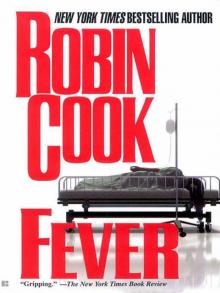 Fever
Fever Death Benefit
Death Benefit Contagion
Contagion Mindbend
Mindbend Coma
Coma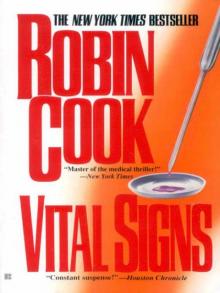 Vital Signs
Vital Signs Harmful Intent
Harmful Intent Critical
Critical Foreign Body
Foreign Body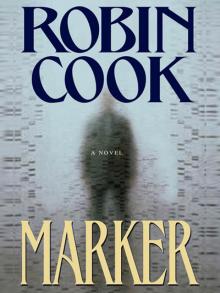 Marker
Marker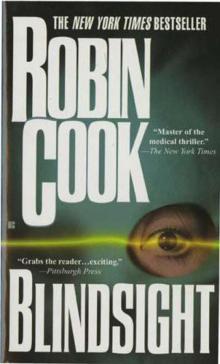 Blindsight
Blindsight Terminal
Terminal Sphinx
Sphinx Fatal Cure
Fatal Cure Host
Host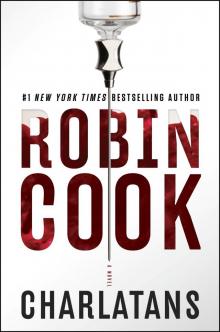 Charlatans
Charlatans Crisis
Crisis Vector
Vector Toxin
Toxin Abduction
Abduction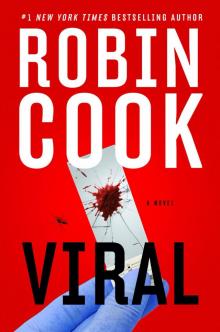 Viral
Viral Pandemic
Pandemic Outbreak
Outbreak Vector js&lm-4
Vector js&lm-4 Godplayer
Godplayer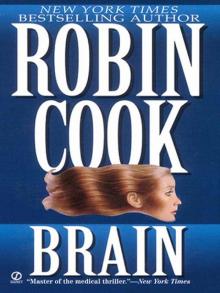 A Brain
A Brain Year of the Intern
Year of the Intern Outbreak dmb-1
Outbreak dmb-1 Cure
Cure Mortal Fear
Mortal Fear The Legend of Parzival
The Legend of Parzival Vital Signs dmb-2
Vital Signs dmb-2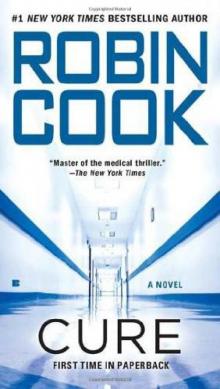 Cure (2010) sam-10
Cure (2010) sam-10 Blindsight sam-1
Blindsight sam-1 The Year of the Intern
The Year of the Intern Intervention sam-9
Intervention sam-9 Foreign Body sam-8
Foreign Body sam-8